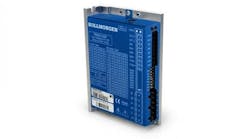Fully Integrated Compact Stepper
March 31, 2010
Related To:
Johnson Electric introduces the Saia® Compact Driver. The Compact Driver is a fully integrated step driver/motor solution that inherently reduces design and integration time, and improves device performance compared with traditional stepper solutions by virtue of reduced parts count and greater immunity to electromagnetic interference. Where space and power is at a premium, the Compact Driver’s low power consumption and small footprint make it a particularly attractive motion solution for battery powered portable devices.The Compact Driver provides 3-wire operation of 28mm Saia motors, including UCL and UCE linear step motors, and UCD and UCB rotary step motors. The linear Compact Driver solution can provide forces from .1 to 50N with a step resolution down to 0.021mm and distances up to 150mm. The rotary Compact Driver solution can be combined with a Saia UGA, UGD or UGM gearbox to obtain higher torque and RPM outputs, and increase step resolution, all from the same integrated driver board.“With an over-all smaller foot print, decreased components count on the main PCB, and direct three-wire motor operation that simplifies the design effort for the engineer by eliminating programming and cabling needs, and enhancing EMC immunity, the Saia Compact Driver provides significant advantages over conventional two part stepper systems,” says Jason Cooper, Application Engineer. “A 12v or 24v DC power wire and ground, along with a control wire, are all that is need to control the movement of this powerful integrated step motor solution.”The Compact Driver’s algorithm is programmed to detect the end of the motor’s stroke. This automated end stop detection eliminates noise, reduces mechanical stress, and compensates for transverse distance tolerances, thus decreasing system hysteresis and maximizing operating life. Additionally, the Compact Driver is available with three different types of control interfaces that can be used for any number of applications where on/off or proportional functions are desired, making it simple to integrate into new and existing device designs. The ON/OFF mode is simply operated by an external switch where the proportional function is controlled by a 0-10v or pulse width modulation (PMW) signal.





